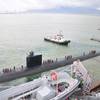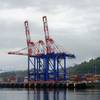Agreement to Develop Gas-Fueled Ships
Wärtsilä and Samsung Heavy Industries (SHI) have signed a co-operation agreement to develop gas-fuelled merchant vessels. The intention is to jointly develop next-generation ships with efficient and competitive propulsion machinery concepts that meet or exceed the demands of future environmental regulations.
The focus of the Wärtsilä/SHI joint study will be on utilizing liquefied natural gas (LNG) as fuel for operating vessels. This is especially relevant in Emission Control Areas (ECAs). Wärtsilä's input will be related to the propulsion machinery, with particular reference to large bore, dual-fuel engines combined with mechanical propulsion solutions. SHI will concentrate on the design of highly efficient vessels incorporating fuel storage facilities and gas-powered propulsion machinery. Merchant vessels to be evaluated include crude oil tankers, for which both optimum propulsion concepts and the performance benefits achieved using LNG as fuel, will be assessed.
"Compared to conventional engines running on heavy fuel oil (HFO), Wärtsilä's dual-fuel engine technology offers 20-25% lower CO2 emissions, 90% lower NOx emissions and almost negligible SOx and particulate emissions," says Mr Jaakko Eskola, Group Vice President, Wärtsilä Ship Power. "We are the market leader in dual-fuel engine technology and deliveries, and our engine portfolio covers the majority of merchant vessel propulsion needs. In gas mode, our dual-fuel engines already comply with the IMO's Tier III regulations which come into force in 2016."
For many decades, engines running on HFO have been, and still are, the market standard for propulsion and electric power generation in merchant vessels. While HFO represents the cheapest available source of primary energy, future environmental regulations will require technologies with lower levels of emissions. ECAs, wherein emissions of NOx, SOx and particulates by marine engines will be regulated, have been announced under IMO Tier III, and the number of ECAs in different regions of the world is expected to rise.
Increasingly tough environmental regulations will open up opportunities for new solutions incorporating cost-efficient technology, and this could trigger a substantial shift towards gas-powered dual-fuel vessels. The need to invest in emissions-abatement technology will make the use of liquid fuels increasingly expensive in the future. From a price perspective, LNG is already competitive with liquid fuels, but further investment in the supply chain is necessary to encourage widespread use in the shipping industry.












